Juniper, One-Seed - Juniperus monosperma
(New Mexico Cedar, Cherrystone Juniper, Sabina)
The Tree
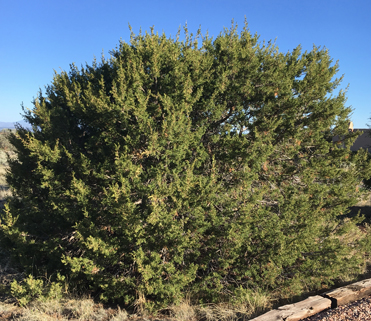 |
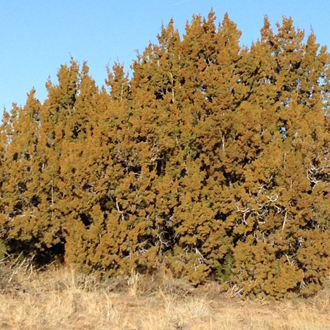 |
Female Tree |
Male Tree |
The Cones
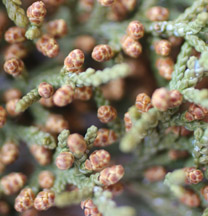 |
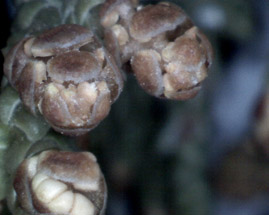 |
Male Cones |
Male Cones 50X |
Foliage and Berries

The Female Cones
 |
 |
50X |
100X |
Distribution
"Juniperus monosperma (one-seed juniper) is a species of juniper native to western North America, in the United Statesin Arizona, New Mexico, southern Colorado, western Oklahoma (Panhandle), and western Texas, and in Mexico in the extreme north of Chihuahua. It grows at 970–2300 m altitude." (Wikipedia)
Description
"It is an evergreen coniferous shrub or small tree growing to 2–7 m (rarely to 12 m) tall, usually multistemmed, and with a dense, rounded crown. The bark is gray-brown, exfoliating in thin longitudinal strips, exposing bright orange brown underneath. The ultimate shoots are 1.2–1.9 mm thick. The leaves are scale-like, 1–2 mm long and 0.6–1.5 mm broad on small shoots, up to 10 mm long on vigorous shoots; they are arranged in alternating whorls of three or opposite pairs. The juvenile leaves, produced on young seedlings only, are needle-like. The cones are berry-like, with soft resinous flesh, subglobose to ovoid, 5–7 mm long, dark blue with a pale blue-white waxy bloom, and contain a single seed (rarely two or three); they are mature in about 6–8 months from pollination. The male cones are 2–4 mm long, and shed their pollen in late winter. It is usually dioecious, with male and female cones on separate plants, but occasional monoecious plants can be found.[2][3] Its roots have been found to extend to as far as 61m below the surface, making it the plant with the second deepest roots, after Boscia albitrunca.[4]
Frequently, cones can be found with the seed apex exposed; these were formerly sometimes considered a separate species "Juniperus gymnocarpa", but this is now known to be due to insect damage to the developing cones (and can affect many different species of juniper); the seeds from such cones are sterile.[3]" (Wikipedia)
Ethnobotanical Uses
Food:
"The One-seeded Juniper - Juniperus monosperma is used by the native Americans as food, medicine construction and crafts. Puebloans both ancestral and modern use the berries for food. The berries can be eaten either raw or stewed with meat." (Dunmire and Tierney 107)
"The principal individual, non-commercial use of juniper berries today is as a nibble and as a woodsy seasoning. A few will take the edge off hunger. Too many, though, are irritating to the kidneys. In fact, a diuretic is made from the fruit, a teaspoon to a cup of boiling water, drunk cold, a large mouthful at a time, one or two cups a day." (Angier 114)
"Juniper tea, quaffed in small amounts, is one of the decidedly pleasant and vitamin-rich evergreen beverages. Add about a dozen young berryless sprigs to a quart of cold water. Bring this to a boil, cover, reduce the heat, and allow to simmer for ten minutes. Then remove from the fire and steep another ten minutes. Strain and serve like regular tea. For really high Vitamin C content, though, steep overnight after covering with boiling water." (Angier 114)
"Indians used to dry and grind juniper berries and use them for cake and for mush. These berries, too. were sometimes roasted for a coffee substitute. The ripe fruit was also sometimes crushed and sieved and used like butter." (Angier 114)
Juniper, Rocky Montain - Juniperus scopulorum
(Colorado Juniper)
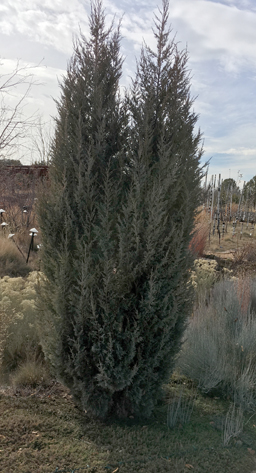 |
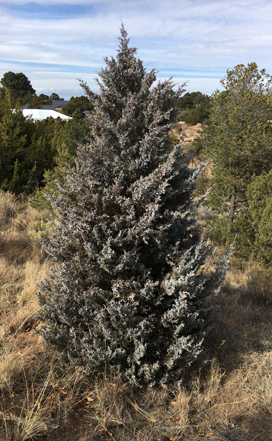 |
Medora |
Moonglow |
Distribution
"Juniperus scopulorum (Rocky Mountain juniper) is a species of juniper native to western North America, in Canada in British Columbia and southwest Alberta, in the United States from Washington east to North Dakota, south to Arizona and also locally western Texas, and northernmost Mexico from Sonora east to Coahuila. It grows at altitudes of 500–2,700 metres (1,600–8,900 ft) on dry soils, often together with other juniper species. (Wikipedia)
Description
Juniperus scopulorum (Rocky Mountain juniper) is a species of juniper native to western North America, in Canada in British Columbia and southwest Alberta, in the United States from Washington east to North Dakota, south to Arizona and also locally western Texas, and northernmost Mexico from Sonora east to Coahuila. It grows at altitudes of 500–2,700 metres (1,600–8,900 ft) on dry soils, often together with other juniper species.[2][3][4][5] "Scopulorum" means "of the mountains.[6]
It is a small tree reaching 1.5-4.5 m (rarely to 6 m) tall, with a trunk up to 300 mm (rarely 600 mm) diameter. The shoots are slender, 0.7–1.2 millimetres (0.028–0.047 in) diameter. The leaves are arranged in opposite decussate pairs, or occasionally in whorls of three; the adult leaves are scale-like, 1–2 mm long (to 5 mm on lead shoots) and 1–1.5 millimetres (0.039–0.059 in) broad. The juvenile leaves (on young seedlings only) are needle-like, 5–10 mm long. The seed conesare berry-like, globose to bilobed, 6–9 millimetres (0.24–0.35 in) in diameter, dark blue with a pale blue-white waxy bloom, and contain two seeds (rarely one or three); they are mature in about 18 months. The pollen cones are 2–4 millimetres (0.079–0.157 in) long, and shed their pollen in early spring. It is dioecious, producing cones of only one sex on each tree.[2][3][5]" (Wikipedia)
Ethnobotanical Uses
Medicine:
"Some Plateau Indian tribes boiled an infusion from the leaves and inner bark to treat coughs and fevers. The cones were also sometimes boiled into a drink used as a laxative and to treat colds.
Among many Native American cultures, the smoke of the burning cedar is used to drive away evil spirits prior to conducting a ceremony, such as a healing ceremony." (Wikipedia)
Juniper, Alligator - Juniperus deppeana
Description
"Juniperus deppeana (alligator juniper or checkerbark juniper; Native American (names include táscate and tláscal) is a small to medium-sized tree reaching 10–15 m (rarely to 25 m) tall. It is native to central and northern Mexico (from Oaxaca northward) and the southwestern United States (Arizona, New Mexico, western Texas). It grows at moderate altitudes of 750–2,700 meters (2,460–8,860 ft) on dry soils.
The bark is usually very distinctive, unlike other junipers, hard, dark gray-brown, cracked into small square plates superficially resembling alligator skin; it is however sometimes like other junipers, with stringy vertical fissuring. The shoots are 1-1.5 mm diameter; the leaves are arranged in opposite decussate pairs or whorls of three; the adult leaves are scale-like, 1-2.5 mm long (to 5 mm on lead shoots) and 1-1.5 mm broad. The juvenile leaves (on young seedlings only) are needle-like, 5–10 mm long. The cones are berry-like, 7–15 mm in diameter, green maturing orange-brown with a whitish waxy bloom, and contain 2-6 seeds; they are mature in about 18 months. The male cones are 4–6 mm long, and shed their pollen in spring. It is largely dioecious, producing cones of only one sex on each tree, but occasional trees are monoecious." (Wikipedia)